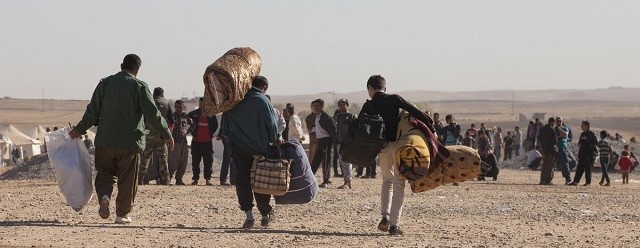Description

Disclaimer: Copyright infringement not intended.
Context
- With the reported increase of nearly 20 percent from the previous year, the number of internally displaced people (IDPs) around the world reached 71 million as of the end of 2022, according to the Internal Displacement Monitoring Centre (IDMC)'s annual report.
Highlights
- The number of movements in which people fled in search of safety and shelter, sometimes more than once, was also unprecedented in 2022 with the figure of 60.9 million which was up 60 per cent from the previous year.
- The conflict in Ukraine triggered nearly 17 million displacements as people fled repeatedly from rapidly shifting frontlines, and monsoon floods in Pakistan triggered 8.2 million, accounting for a quarter of the year’s global disaster displacement.
- Factors like food insecurity, climate change and escalating and protracted conflicts are adding new layers to this phenomenon.
The scale of the problem
- Internal displacement is a global phenomenon, but nearly three-quarters of the world’s IDPs live in just 10 countries - Syria, Afghanistan, the Democratic Republic of the Congo (DRC), Ukraine, Colombia, Ethiopia, Yemen, Nigeria, Somalia and Sudan.
- Conflict and violence triggered 28.3 million internal displacements worldwide, a figure three times higher than the annual average over the past decade.
- The number of disaster displacements rose by nearly 40 per cent compared to the previous year, reaching 32.6 million.
- South Asia recorded the highest regional figure, surpassing East Asia and the Pacific for the first time in a decade.
- Conflict and disasters combined last year to aggravate people’s pre-existing vulnerabilities and inequalities, triggering displacement on a scale never seen before.

Who are internally displaced persons?
- According to the Guiding Principles on Internal Displacement, internally displaced persons are "persons or groups of persons who have been forced or obliged to flee or to leave their homes or places of habitual residence, in particular as a result of or in order to avoid the effects of armed conflict, situations of generalized violence, violations of human rights or natural or human-made disasters, and who have not crossed an internationally recognized border."
What challenges do internally displaced persons face?
- People forced to flee or leave their homes are generally subject to heightened vulnerability in a number of areas.
- Displaced persons suffer significantly higher rates of mortality than the general population.
- They also remain at high risk of physical attack, sexual assault and abduction, and frequently are deprived of adequate shelter, food and health services.
- The overwhelming majority of internally displaced persons are women and children who are especially at risk of abuse of their basic rights.
What is the difference between an internally displaced person and a refugee?
- According to the 1951 Convention on the Status of Refugees, a "refugee" is a person who, "owing to well-founded fear of being persecuted for reasons of race, religion, nationality, membership of a particular social group or political opinion, is outside the country of his nationality and is unable, or owing to such fear, is unwilling to avail himself of the protection of that country; or who, not having a nationality and being outside the country of his former habitual residence as a result of such events, is unable or, owing to such fear, is unwilling to return to it."
- Subsequent international instruments (such as the Cartagena Declaration on Refugees and the Convention Governing the Specific Aspects of Refugee Problems in Africa) have expanded this definition.
- A crucial requirement to be considered a "refugee" is crossing an international border.
- Persons forcibly displaced from their homes who cannot or choose not to cross a border, therefore, are not considered refugees.
- Unlike refugees, these internally displaced persons do not have a special status in international law with rights specific to their situation.
What rights do internally displaced persons have?
- Like all human beings, internally displaced persons enjoy human rights that are articulated by international human rights instruments and customary law.
- The Guiding Principles on Internal Displacement, created in 1998, restate and compile existing international human rights and humanitarian law germane to the internally displaced.
|
GUIDING PRINCIPLES
- Arbitrary displacement in the first instance is prohibited.
- Once persons have been displaced, they retain a broad range of economic, social, cultural, civil and political rights, including the right to basic humanitarian assistance, the right to be protected from physical violence, the right to education, freedom of movement and residence, political rights such as the right to participate in public affairs and the right to participate in economic activities.
- Displaced persons also have the right to assistance from competent authorities in voluntary, dignified and safe return, resettlement or local integration, including help in recovering lost property and possessions.
- When restitution is not possible, the Guiding Principles call for compensation or just reparation.
|
Whose responsibility is it to protect and assist internally displaced persons?
- As a crucial element of sovereignty, it is the Governments of the states where internally displaced persons are found that have the primary responsibility for their assistance and protection.
- The international community's role is complementary.
Indian scenario
- In India, there are 9,29,318 displaced people. Out of this, the number of IDPs due to violence and conflict stood at 4,73,000 as of December 2020.
- Since Independence, India has time and again witnessed bouts of violent clashes amongst communities which have led to large-scale displacement -- exodus of the Kashmiri Pandits in 1989, the violence in the Northeast including the Nellie massacre of 1983, the exodus of Bru tribes from Mizoram in 1997, the Gujarat riots of 2002, the anti-Sikh riots of 1984, the Muzaffarnagar riots of 2013, and the recent clashes in Northeast Delhi.
- In 2022, the number of disaster displacements reduced by nearly half compared to the previous year, totalling 2.5 million. Floods triggered 96 per cent of them.
- In terms of conflict and violence, there is no systematic data collection on displacement in India. Figures totalled just over 1,000 in 2022, the result of localised events of intercommunal violence.
The Existing Legal Framework for Internally Displaced Persons
- Internally Displaced people broadly fit into three categories: displaced due to natural disasters, displaced due to development activities like dam constructions, and displaced due to instances of violence and conflict.
- India has laws in place for the first two categories — The Land Acquisition Act, 2013, and the Disaster Management Act, 2005.
- But there is no law as such for the third category of displaced persons in India.
- Rehabilitation of displaced communities is carried out by the State governments with the help of the Centre through various rehabilitation and assistance schemes.
- Currently, there are seven sub-schemes under an umbrella scheme called “Relief and Rehabilitation of Migrants and Repatriates” for 2021-22 to 2025-26 with a total outlay of Rs 1,452 crores.
.jpeg)
Concluding remarks
- The level of compensation and treatment to internally displaced persons varies from state to state.
- Dealing with this kind of displacement will require a quite different approach though. First - there's the question of justice. If such groups and communities cannot access justice then any attempt to compensate or rehabilitate will be incomplete or inadequate.
MUST READ ARTICLES:
About UN High Commissioner for Refugees: https://www.iasgyan.in/daily-current-affairs/un-high-commissioner-for-refugees
|
PRACTICE QUESTION
Q) The inability of displaced people in India to access justice and rehabilitation remains a constant concern throughout history. Comment. (250 words)
|
https://timesofindia.indiatimes.com/world/rest-of-world/war-natural-disasters-left-record-71-million-people-internally-displaced-in-2022-report-says/articleshow/100149783.cms?from=mdr









